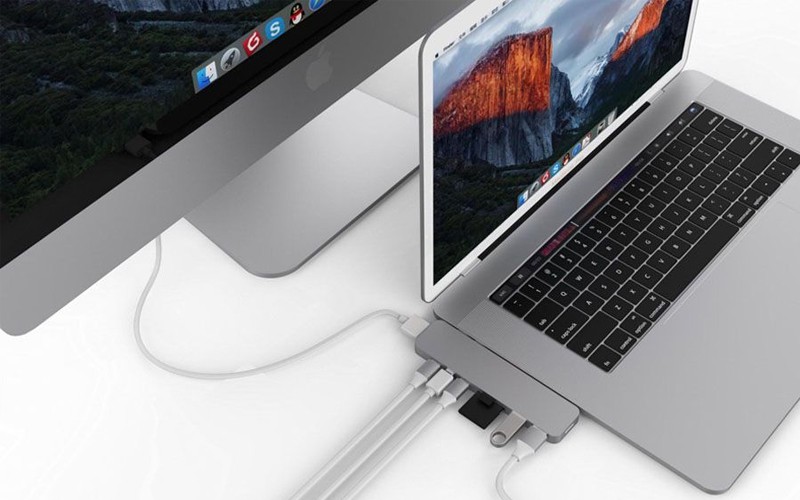
- #Usb hub for macbook pro 2011 mac os x
- #Usb hub for macbook pro 2011 full
- #Usb hub for macbook pro 2011 pro
Not to mention, the sensitivity and responsiveness is just right (though, the speed can be adjusted if need be). The 4.2 x 3.0-inch pad is plenty wide for accommodating the slew of new multitouch gestures supported in Lion. It’s hard not to gush about Apple’s glass touchpad - it simply continues to be the best in the business.
#Usb hub for macbook pro 2011 pro
(The VAIO Z suffers from the same thing.) It’s certainly not a deal breaker of any sort, but I do prefer the slightly more raised keys on the MacBook Pro and the Samsung Series 9. (You can disable the ambient light sensor and adjust the backlight manually with the F5 and F6 keys - that’s my preference.) However, my one complaint about the panel is the shallow travel of the keys, which is ultimately caused by the thinner profile. The chiclet keyboard has gone pretty much unchanged save for the (re-)addition of the backlight and the addition of the LaunchPad and Mission Control function keys, which took the place of the Expose and Dashboard shortcuts. It’s really more of the same when it comes to the bottom deck - Apple’s simply not messing with a great thing. Of course, one minor aesthetic change that masks a major functionality change is the addition of a Thunderbolt logo on the right side of the mini-DisplayPort - but we’ll get to that later. (Seriously, why don’t hotels have Wi-Fi in the rooms?) Apple offers a USB-to-Ethernet adapter for $29 - just don’t forget to pack it. There’s still no on-board Ethernet port, which can lead to a very frustrating experience when traveling. The Air is still stocked with two USB ports (thankfully, on opposite edges), a 3.5mm headphone jack, and an SD card reader. The minimalist aesthetic is really unmatched I carried ‘em both home from the office and together they didn’t seem to weigh as much as my 4.5-pound 13-inch MacBook Pro.


4 pounds more than the Z, but you’re absolutely not going to notice the difference on your shoulder. The three-pound 13-inch MacBook Air does weigh.

02-inches thicker than the VAIO Z, but the Air’s thinner front edge definitely gives it the illusion of being the thinnest laptop on shelves. When closed, the chassis still tapers like a tear drop, measuring 0.11 inches at the thinnest point and 0.68 at the thickest. Seriously, the rigidity of the hinge is downright impressive. (Sadly, those black MacBook Air rumors didn’t pan out this time around - next time, perhaps.) In comparison to Sony’s flimsy screen panel, Apple’s is like a brick wall. And while the all-black Sony VAIO Z might appeal to some more than the Air’s grayish aluminum, the Air’s metal build certainly feels more rigid than the VAIO’s carbon fiber case and floppy screen. The aluminum unibody construction has proved to be incredibly sturdy and the minimalist aesthetic is really unmatched there’s a reason companies like Dell and HP have moved over to building their laptops out of similar materials and cut the glossy plastics. The new 13-inch MacBook Air doesn’t look any different than its predecessor, but I don’t think anyone is going to complain - I certainly won’t.
#Usb hub for macbook pro 2011 full
Read on after the break for my full review. Yes, it physically looks the same and those may seem like just minor spec updates, but the additions change a heck of a lot more than you’d think.
#Usb hub for macbook pro 2011 mac os x
And it boots Apple’s brand new Mac OS X Lion (10.7), which we’ve already deemed pretty great. The Air is now stuffed with a fresh dual-core Core i5 processor (there’s an i7 option too), a glowing keyboard, and a new Thunderbolt port. Which brings us to Apple’s 2011 version of the 13-inch MacBook Air and this review. And in a tragic oversight, the keyboard wasn’t backlit. If you didn’t need an optical drive, it had almost about everything it needed to be both a no-compromise ultraportable and a primary computer, but the older processors still didn’t offer quite enough performance to do the job.

The second Air (or heir!) was priced significantly less at $1,299 ($999 for the 11-inch version), included some speedy solid state drives, and mended some of those port issues. If I think back, they were actually pretty rare to see out and about, and when I would spot one, I can remember thinking “that guy must have a nice car, too.”īut then came the major revision (the original Air got a slight spec bump in 2008, but it didn’t change much). For most, the sacrifices were just too many to justify for the high price. Sure, it was a functional laptop that could glide into a manila envelope, but the $1,799 laptop was, by and large, a secondary machine - it trailed behind other ultraportables in performance, lacked some essential ports (it only had one USB port and there was no SD card slot), and packed a small and slow hard drive. The original MacBook Air was more of a status symbol than a computer.


 0 kommentar(er)
0 kommentar(er)
